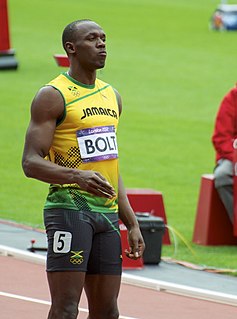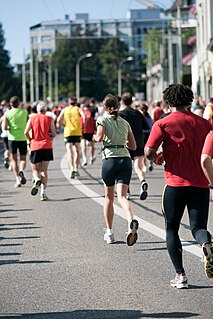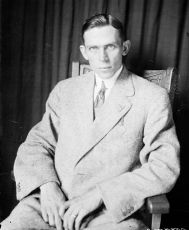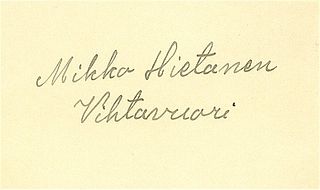
Running is a method of terrestrial locomotion allowing humans and other animals to move rapidly on foot. Running is a type of gait characterized by an aerial phase in which all feet are above the ground. This is in contrast to walking, where one foot is always in contact with the ground, the legs are kept mostly straight and the center of gravity vaults over the stance leg or legs in an inverted pendulum fashion. A characteristic feature of a running body from the viewpoint of spring-mass mechanics is that changes in kinetic and potential energy within a stride occur simultaneously, with energy storage accomplished by springy tendons and passive muscle elasticity. The term running can refer to any of a variety of speeds ranging from jogging to sprinting.

Sprinting is running over a short distance in a limited period of time. It is used in many sports that incorporate running, typically as a way of quickly reaching a target or goal, or avoiding or catching an opponent. Human physiology dictates that a runner's near-top speed cannot be maintained for more than 30–35 seconds due to the depletion of phosphocreatine stores in muscles, and perhaps secondarily to excessive metabolic acidosis as a result of anaerobic glycolysis.
Middle-distance running events are track races longer than sprints, up to 3000 metres. The standard middle distances are the 800 metres, 1500 metres and mile run, although the 3000 metres may also be classified as a middle-distance event. The 1500 m came about as a result of running 3 3⁄4 laps of a 400 m outdoor track or 7 1⁄2 laps of a 200 m indoor track, which were commonplace in continental Europe in the 20th century.

Long-distance running, or endurance running, is a form of continuous running over distances of at least 3 kilometres (1.8 miles). Physiologically, it is largely aerobic in nature and requires stamina as well as mental strength.

Track and field is a sport which includes athletic contests established on the skills of running, jumping, and throwing. The name is derived from where the sport takes place, a running track and a grass field for the throwing and some of the jumping events. Track and field is categorized under the umbrella sport of athletics, which also includes road running, cross country running, and race walking.

The 800 metres, or 800 meters, is a common track running event. It is the shortest common middle-distance running event. The 800 metres is run over two laps of the track and has been an Olympic event since the first games in 1896. During indoor track season the event is usually run on a 200-metre track, therefore requiring four laps.

Melvin Whinfield "Peerless Mel" Sheppard was an American athlete, member of the Irish American Athletic Club and winner of four gold medals at the 1908 Summer Olympics and 1912 Summer Olympics. Along with Henry Taylor of the United Kingdom, he was the most successful athlete at the 1908 Olympics.
Ted Corbitt was an American long-distance runner and an official of running organizations. Corbitt is often called "the father of long distance running." He was an ultramarathon pioneer, helping to revive interest in the sport in the United States in the 1960s and 1970s. New York Times columnist Robert Lipsyte called Corbitt a "spiritual elder of the modern running clan". In a Runner's World feature honoring lifetime achievement, writer Gail Kislevitz called Corbitt a "symbol of durability and longevity".
This page contains an overview of the year 1984 in the sport of athletics.
This page contains an overview of the year 1985 in the sport of athletics.
This page contains an overview of the year 1986 in the sport of athletics.
This page contains an overview of the year 1983 in athletics.
This page contains an overview of the year 1987 in athletics.
This page contains an overview of the year 1989 in athletics.
This page contains an overview of the year 1982 in athletics.
This page contains an overview of the year 1981 in athletics.
This page contains an overview of the year 1980 in athletics. The major athletics event of the year was the 1980 Moscow Olympics. A boycott of this competition meant many of world's leading athletes did not face each other, with many of the boycotting athletes taking part in the rival Liberty Bell Classic competition.
Michael J. "Mike" Ryan was an American track and field athlete and a member of the Irish American Athletic Club. He was a distance runner and competed in the Marathon for the U.S. Olympic team in the 1908 Summer Olympics and 1912 Summer Olympics, but did not finish either race.
Events in the year 1997 in Germany.









